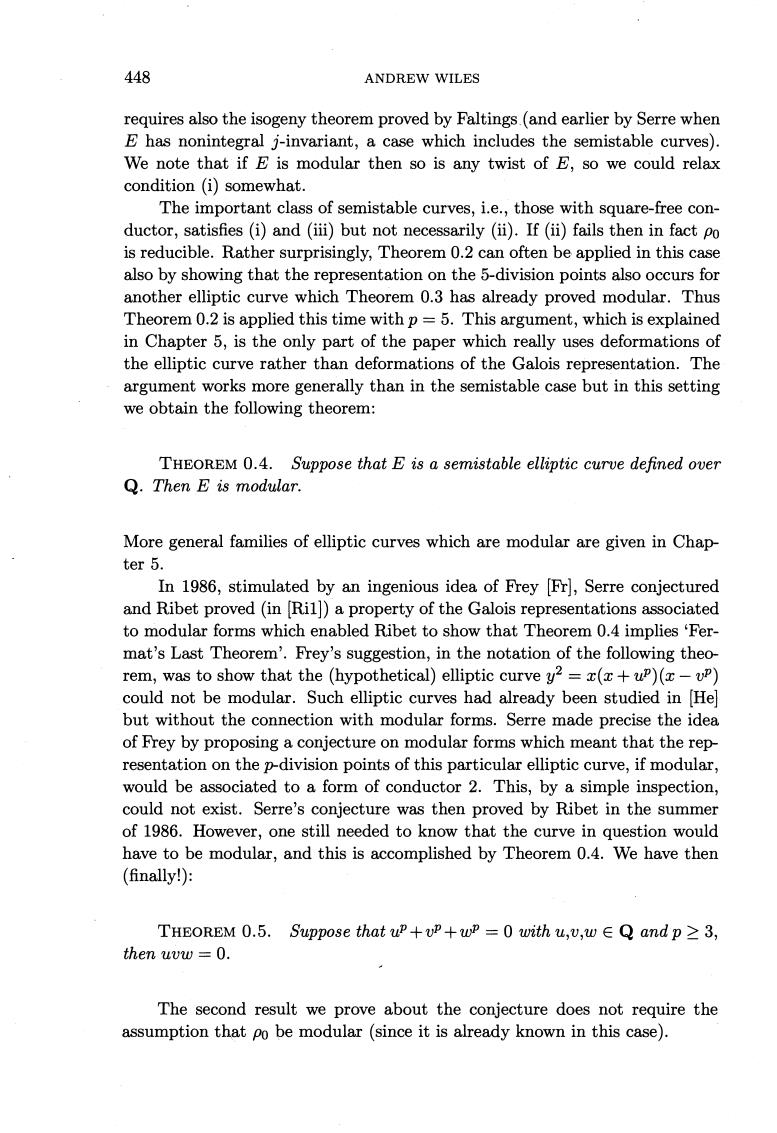正在加载图片...

448 AnDrew WILES requires also the isogeny theorem proved by Faltings (and earlier by Serre when E has nonintegral invariant,acase which includes the semistable curves) We note that if E is modular then so is any twist of E,so we could relax condition (i)somewhat. The important of semistable curves,with square-freecon ductor,satisfies(i)and (iii)but not necessarily (ii).If(ii)fails then in fact po is reducible.Rather surprisingly,Theorem 0.2 can often be applied in this case also by showing that the repre entation on the 5-division points also occurs for another elliptic curve which Theorem 0.3 has already proved modular.Thus Theorem 0.2 is applied this time with p=5.This argument,which is explained in Chapter 5,is the only part of the paper which really uses deformations of the elliptic curve rather than deformations of the Galois representation.The argument works more generally than in the semistable case but in this setting we obtain the following theorem: THEOREM 0.4.Suppose that E is a semistable elliptic curve defined over Q.Then E is modular. More general families of elliptic curves which are modular are given in Chap- ter 5. In 1986,stimulated by an ingenious idea of Frey Fr],Serre conjectured and Ribet proved(in Ril])a property of the Galois representations associated to modular forms which enabled Ribet to show that Theorem 0.4 implies 'Fer- mat's Last Theorem'.Frey's suggestion,in the notation of the follo wing thec rem,was to show that the (hypothetical)elliptic curve y2=x(x+uP)(x-uP) could not be modular.Such elliptic curves had already been studied in He but without the connection with modular forms s.Serre e made precise the ide of Frey by proposing a conjecture on modular forms which meant that the rep- resentation on the p-division points of this particular elliptic curve,if modular, would be associated to a form of conductor 2.This,by a simple inspection could not exist.Serre's conjecture was then proved by Ribet in the summer of 1986.However,one still needed to know that the curve in question would have to be modular,and this is accomplished by Theorem 0.4.We have then (finally!): THEOREM0.5.Suppose that uP+vP+wP=0 with u,v,w∈Qandp≥3, then uvw=0. The prove about the conjecture does not require the assumption that po be modular(since it is already known in this case). 448 ANDREW WILES requires also the isogeny theorem proved by Faltings (and earlier by Serre when E has nonintegral j-invariant, a case which includes the semistable curves). We note that if E is modular then so is any twist of E, so we could relax condition (i) somewhat. The important class of semistable curves, i.e., those with square-free conductor, satisfies (i) and (iii) but not necessarily (ii). If (ii) fails then in fact po is reducible. Rather surprisingly, Theorem 0.2 can often be applied in this case also by showing that the representation on the 5-division points also occurs for another elliptic curve which Theorem 0.3 has already proved modular. Thus Theorem 0.2 is applied this time with p = 5. This argument, which is explained in Chapter 5, is the only part of the paper which really uses deformations of the elliptic curve rather than deformations of the Galois representation. The argument works more generally than in the semistable case but in this setting we obtain the following theorem: THEOREM0.4. Suppose that E is a semistable elliptic curve defined over Q. Then E is modular. More general families of elliptic curves which are modular are given in Chap ter 5. In 1986, stimulated by an ingenious idea of Frey [Fr], Serre conjectured and Ribet proved (in [Rill) a property of the Galois representations associated to modular forms which enabled Ribet to show that Theorem 0.4 implies 'Fermat's Last Theorem'. Frey's suggestion, in the notation of the following theorem, was to show that the (hypothetical) elliptic curve y2 = x(x +up)(x -up) could not be modular. Such elliptic curves had already been studied in [He] but without the connection with modular forms. Serre made precise the idea of Frey by proposing a conjecture on modular forms which meant that the rep resentation on the pdivision points of this particular elliptic curve, if modular, would be associated to a form of conductor 2. This, by a simple inspection, could not exist. Serre's conjecture was then proved by Ribet in the summer of 1986. However, one still needed to know that the curve in question would have to be modular, and this is accomplished by Theorem 0.4. We have then (finally!): THEOREM0.5. Suppose that up+vp+wp = 0 with u,v,w E Q andp > 3, then uvw = 0. The second result we prove about the conjecture does not require the assumption that po be modular (since it is already known in this case)